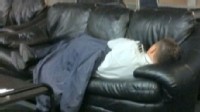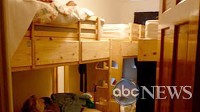Despite denials from the airline industry, large numbers of pilots report to duty every day after getting only a few hours of what fatigue experts call "destructive sleep" in crowded crew lounges and so-called "crash pads," an ABC News investigation has found. Widespread pilot fatigue is putting airline passengers at risk, say critics, and may already have cost lives.
Current and former pilots described missing radio calls, entering incorrect readings in instruments and even falling asleep in mid-flight in the report to be broadcast tonight on "World News with Diane Sawyer" and "Nightline".
Former Continental Express pilot Josh Reikes says one captain warned him, "Don't you ever let me wake up and find you sleeping."
America's most famous pilot, Captain Chesley "Sully" Sullenberger, doubts he could have landed his stricken U.S. Airways jet safely in the Hudson River, saving all 155 people aboard, if he had been sleep-deprived.
"Had we been tired, had we not gotten sufficient rest the night before," said Sullenberger, "we could not have performed at the same level."
Sullenberger says fatigue is an industry-wide problem that "needs to be fixed, and has needed to be fixed for 30 years."
"We have to create a situation in which it's possible" for pilots to get a good, affordable night's sleep, he said. "We have to value this profession enough that people don't have to live out of a crash pad or a crew room."


 CLICK HERE to go inside a crash pad and crew lounge.
CLICK HERE to go inside a crash pad and crew lounge.
Dr. Martin Moore-Ede, a fatigue expert who consults for airlines, unions and the government, said that it would be hard for pilots to get adequate rest in the kinds of places where many try to sleep.
"We're getting a different answer than you're getting, so somewhere there's a gap," FAA administrator Randy Babbitt told ABC News. "We asked the carriers themselves -- they're their crew lounges -- is this going on or not? We're not getting the kind of answer you are."
Said Babbitt, "They're telling us it simply isn't going on."
Sullenberger, who retired after his famous Hudson landing in January 2009, says that it is going on. He called fatigue a "big concern," and said, "Our passengers deserve better."
When asked if he feared something bad could come out of pilot fatigue, Sullenberger said, "It has already happened."
In the past 20 years, more than two dozen accidents and more than 250 fatalities have been linked to pilot fatigue, according to the NTSB. There have been near misses, like a Mesa Airlines flight from Honolulu destined for Hilo, Hawaii, with 40 passengers and three crew aboard on Feb. 13, 2008, nearly a year to the day before the Continental 3407 crash. The plane flew past its destination without landing and headed out over the Pacific. The NTSB found that both pilots had fallen asleep and did not respond to calls from controllers for 18 minutes.
Current and former pilots described missing radio calls, entering incorrect readings in instruments and even falling asleep in mid-flight in the report to be broadcast tonight on "World News with Diane Sawyer" and "Nightline".
Former Continental Express pilot Josh Reikes says one captain warned him, "Don't you ever let me wake up and find you sleeping."
America's most famous pilot, Captain Chesley "Sully" Sullenberger, doubts he could have landed his stricken U.S. Airways jet safely in the Hudson River, saving all 155 people aboard, if he had been sleep-deprived.
"Had we been tired, had we not gotten sufficient rest the night before," said Sullenberger, "we could not have performed at the same level."
Sullenberger says fatigue is an industry-wide problem that "needs to be fixed, and has needed to be fixed for 30 years."
"We have to create a situation in which it's possible" for pilots to get a good, affordable night's sleep, he said. "We have to value this profession enough that people don't have to live out of a crash pad or a crew room."

Brian Ross Investigates Pilot Fatigue Watch Video

Inside Airline Pilot 'Crash Pads' Watch Video

Exclusive: Sully Says 'Passengers Deserve Better' Watch Video
Dr. Martin Moore-Ede, a fatigue expert who consults for airlines, unions and the government, said that it would be hard for pilots to get adequate rest in the kinds of places where many try to sleep.
FAA Administrator: 'They're Telling Us It Simply Isn't Going On'
Undercover video of crew lounges taken by pilots and provided to ABC News shows pilots asleep in chairs and on sofas. The practice is contrary to airline rules -- and also contradicts what the head of the Federal Aviation Adminstration says he's been told by industry representatives."We're getting a different answer than you're getting, so somewhere there's a gap," FAA administrator Randy Babbitt told ABC News. "We asked the carriers themselves -- they're their crew lounges -- is this going on or not? We're not getting the kind of answer you are."
Said Babbitt, "They're telling us it simply isn't going on."
Sullenberger, who retired after his famous Hudson landing in January 2009, says that it is going on. He called fatigue a "big concern," and said, "Our passengers deserve better."
When asked if he feared something bad could come out of pilot fatigue, Sullenberger said, "It has already happened."
In the past 20 years, more than two dozen accidents and more than 250 fatalities have been linked to pilot fatigue, according to the NTSB. There have been near misses, like a Mesa Airlines flight from Honolulu destined for Hilo, Hawaii, with 40 passengers and three crew aboard on Feb. 13, 2008, nearly a year to the day before the Continental 3407 crash. The plane flew past its destination without landing and headed out over the Pacific. The NTSB found that both pilots had fallen asleep and did not respond to calls from controllers for 18 minutes.


No comments:
Post a Comment